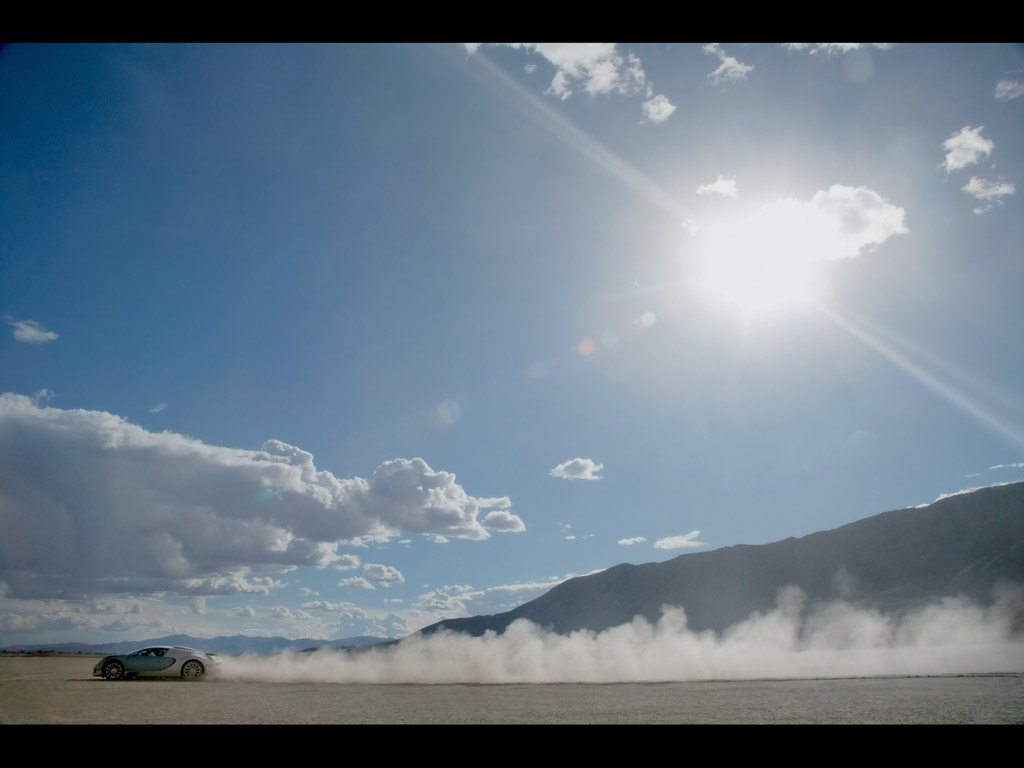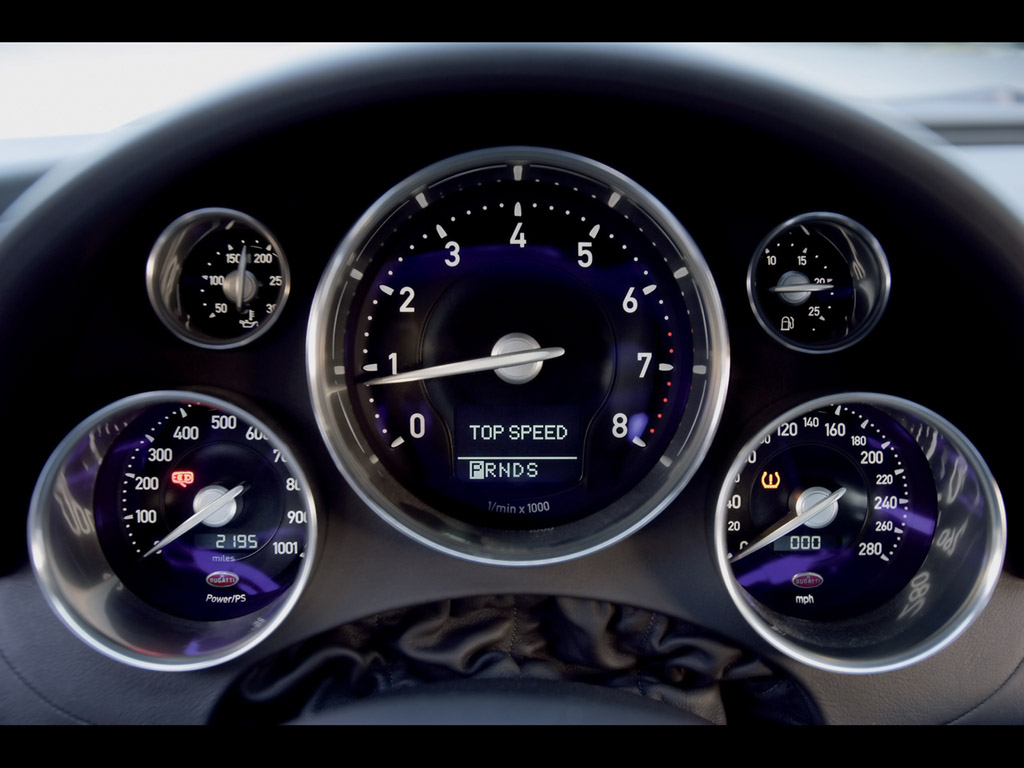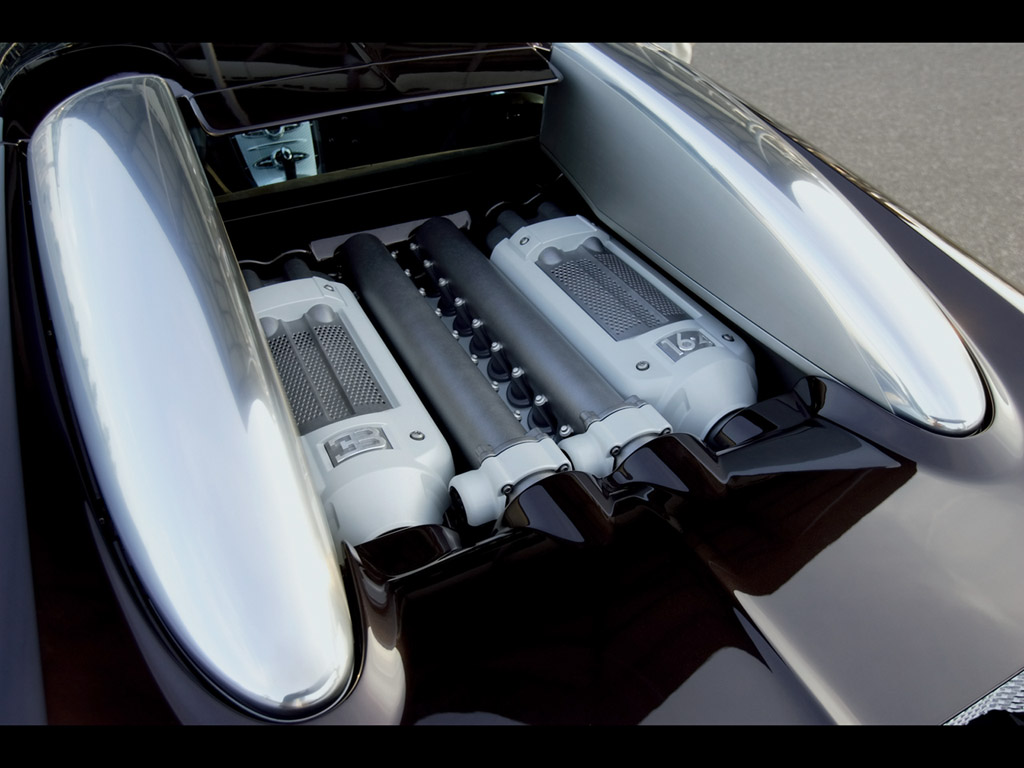2006 Bugatti Veyron at the Targa Florio
|
Price |
approximately $1 million |
Production |
300 (projected) | ||
|
Engine |
8 liter W16 |
Weight |
4162 lbs | ||
|
Aspiration |
4 turbochargers |
Torque |
922 lb-ft @ 2200-5500 rpm | ||
|
HP |
1001 hp @ 6000 rpm |
HP/Weight |
4.2 lbs per hp | ||
|
HP/Liter |
125 hp per liter |
0-186 mph |
16.7 seconds | ||
|
0-62 mph |
2.5 seconds |
Top Speed |
253 mph |
(from Bugatti Press Release) From 11th to 18th October 2005, the new Bugatti Veyron 16.4 was presented in Madonie in Sicily, an area known throughout the world as the setting for one of the most illustrious motor races, the Targa Florio. For the first time, on the roads of the legendary course and on the Autodromo di Pergusa in Enna, a wider group of media professionals were able to convince themselves of the qualities of this new super sports car. As Dr. Thomas Bscher, President of Bugatti Automobiles S.A.S., explained: “It is no accident that Bugatti is presenting the new Veyron here in Sicily. Since the acquisition of the rights to the name in 1998, we have not only built a new car, but have also breathed new life into one of the world’s most prestigious automobile marques. And it was on the course of the Targa Florio in the 1920s, with its Type 35 Grand Prix racers – a model that made a vital contribution to the renown of the marque – that Bugatti achieved its most famous victories. Here in Castelbuono I can state clearly – and this is a source of pride for us all – the Bugatti marque is alive and the new Bugatti Veyron 16.4 will ensure its future!”
Another car, 50 years down the road
In 1956, the final
attempts had failed, in the wake of the death of the company’s
founder in 1947 – preceded in death in 1939 by his son Jean, with
whom he collaborated – to keep the substantially weakened company
alive. After 47 years’ production, in the course of which 7,950
Bugattis of models 13 through 251 had been manufactured, the gates
to the Bugatti factory in Molsheim were forced to close. Today,
nearly 50 years later to the day, the production of Bugatti
automobiles in Molsheim is resuming, making Molsheim once again the
hub of the Bugatti world. As a centre for reminiscence, picturesque
town near Strasbourg has never lost its significance. The area’s
“Enthusiasts Bugatti Alsace”, together with their friends in the
various Bugatti clubs throughout the entire world, are in large
measure responsible for keeping the brand alive over the decades –
even in the absence of the product itself. This is an experience in
which various other prestigious automobile brands with melodious
names have not shared. It is in this fact that the strength of the
Bugatti brand values is expressed most clearly. The admiration for
“art on wheels“, the bold pursuit of the aesthetic conviction of
Ettore Bugatti, a man who was first and foremost an artist, not a
technician. The grandeur of the victories in
the glorious years of dirt-encrusted heroes on the racetracks of
this world and, not least, the suitability of these racing cars for
everyday driving – which made Bugatti cars accessible to a broader
clientele. The prestige of inspired design and the exclusiveness of
individual models that helped catapult certain Bugatti models into
the astronomical price classes.
1998 through 1999: Four design studies in 15 months time
In April 1998, the Volkswagen Group took over the Bugatti trademark, presenting the brand to the public for the first time at the International Motor Show in Paris with a study for a two-door coupé it had commissioned Italdesign to create: the Bugatti EB 118. A few months later, in March 1999, at the Geneva Motor Show, a design of the EB 218, itself also created at Italdesign, caused a sensation with a four-door saloon using the same 18-cylinder, 6.3 litre engine with 555 hp. This was followed the same year, at the IAA in Frankfurt, by the centre-engine design, the Bugatti EB 18/3 Chiron; once again Giugiaro was responsible for the design. And shortly thereafter, in Tokyo, the Bugatti EB 18/4 Veyron celebrated its world premiere, a model designed at the “Volkswagen Centre of Excellence Design” under the directorship of Hartmut Warkuss. Less than a year later, in autumn 2000 in Paris, the Veyron 16.4 was shown for the first time. The Bugatti Veyron 16.4 with the ultimate in performance features, the 1,001 hp, 8-litre, 16-cylinder engine and its technological specifications – 1,250 Nm at 2,200 rpm, top speed of more than 400 km/h, four turbochargers and permanent four-wheel drive, features that have remained in place to this day – celebrated its debut at the IAA in Frankfurt in September 2001.
2003: New team – new objectives
In 2001, the decision
was made to go into series production of the Bugatti Veyron 16.4
with a maximum of 300 cars. In December of the following year,
“Bugatti Automobiles S.A.S.” was established, a subsidiary of
“Volkswagen France” with headquarters in Molsheim. And nearly a year
to the day thereafter, at the end of 2003, Dr. Thomas Bscher took
overall charge of the Bugatti project as the new President of
“Bugatti Automobiles S.A.S.” Appointed to assist him was Dr.
Wolfgang Schreiber, serving as technical director and simultaneously
as head of “Bugatti Engineering GmbH” in Wolfsburg, where all of the
development work for the new Bugatti is co-ordinated and, in part,
carried out. His task was to put the Bugatti Veyron 16.4 on the
road.
The new team subjected the entire project to a technological and
financial feasibility study commissioned, among other things, to
develop a realistic timeframe for the launch of production of the
new Bugatti. Shortly before the 2004 Geneva Motor Show, the
Executive Board at the Group approved plans for the “new” Veyron
project, scheduling production to begin in September 2005. This
schedule has been met to this day.
The Veyron: An unrivalled synthesis of top performance and the everyday
This is made all the more remarkable by the fact that the Bugatti Veyron 16.4, despite its very limited production, is called upon to meet all of the specifications of the VW Group in their entirety. This means innumerable time-consuming trials and tests throughout the entire world, all devoted to the fulfillment of a single objective: to measure up to the strict, indeed relentless quality and quality-assurance standards the company has laid down. This ensures that this super sports car will be suitable for everyday driving as well, to a degree never before witnessed in any other series-production vehicle of this type. In the world of modern, series-production automobiles, the synthesis which has been brought to fruition in the Bugatti Veyron 16.4 is between easy and problem-free operation in day-to-day traffic and breathtaking driving in the high-performance area. A reference which would be music to the ears of Ettore Bugatti, whose early successes were themselves rooted in this unique combination. Extensive construction work in MolsheimParallel to the ongoing activities in the product area, extensive construction work has been launched at the location in Molsheim. To begin with, the Château St. Jean – an edifice that Ettore Bugatti never used as a residence but rather only as a form of what, in today’s parlance would be termed a customer service centre –, was completely renovated. The two stalls located to the south and the north of the castle, which in Bugatti’s day served as stables, were telemetrically surveyed, dismantled and, using as many of the original elements of the structure as were still usable, such as wall segments and woodwork, reconstructed in a faithful copy of the original structures. In this new “Bugatti Era”, these structures will for the most part have an administrative character; in one of the spaces, clients will also be able to take possession of their Bugatti Veyron in a historical setting.
The core of the investments made in Molsheim is the “Atelier” in which production of the Bugatti Veyron 16.4 is beginning in September 2005. In its architectural form, this modern production facility has been given stylistic features dipping back into the history of the automotive brand. With a southern exposure, the light-filled, glazed main hall is only partly evocative of an automobile-manufacturing operation in the classical sense of the term – it reminds the beholder more of a “Formula One laboratory”. The setting is dominated by clinical cleanliness and precision workmanship with highly developed component parts. And yet the “Atelier” can still hold its own against the “major players”. A runway for the measurement of relevant functional performance data and a generously proportioned water-spraying system for testing vehicle water tightness are to be found here, alongside a light chamber under the glaring lamps of which the slightest inconsistency in a car’s paintwork mercilessly catches the eye. A small test course has been laid out in the green spaces in front of the building. It can be used to supplement the road-test program compulsory for all Veyrons and which concludes the vehicle’s production process. A logistics centre erected next to the “Atelier” rounds off the complex of buildings in Molsheim.
Historic location
Thanks to Bugatti,
Molsheim has been elevated from anonymity to find its own place on
the map – not just of the automotive world. And this is certainly
justified, as it was the location of both Ettore Bugatti‘s
production facilities and his adjacent private residence. In purely
geographical terms, circumstances have changed somewhat since the
purchase of the Château St. Jean and the property surrounding it ,
which covers 140,000 m2 and on which all other modern-day Bugatti
activities take place. To be precise, the property is situated in
Dorlisheim which, while within sight of the former Bugatti factory,
is nevertheless located on the other side of the Bruche River. This
has been the source of inspiration for a “postal sleight of hand” on
the part of the new management at Bugatti. To be able to carry the
historic value of the location in Molsheim into the Bugatti future
while at the same time satisfying the administrative regulations of
the federal state, a compromise was negotiated with local
authorities. A Solomonic solution was arrived at with the latter,
who took a very favourable view of the entire Bugatti project right
from the beginning, providing their active support through-
out its development. The correct and complete address of Bugatti
“Cru 2005” is: Bugatti Automobiles S.A.S., 1, Château St. Jean,
Dorlisheim, F-67 120 Molsheim.
Bugatti is on the threshold of a new era. Its location is Molsheim.
The company is international. Ettore Bugatti was born in 1881 in
Italy. He completed his technological instruction in Germany, first
with de Dietrich in Niederbronn in Alsace – at the time still a part
of Germany – and then at Deutz in Cologne, before he built his first
automobile in 1909 in Molsheim. Since 1998, Bugatti has belonged to
the Volkswagen Group as a French company with a French headquarters.
The modern-day Bugatti team – every bit as international as the company itself – views the legacy of Ettore Bugatti as both a challenge and an obligation. As Dr. Thomas Bscher, President of Bugatti Automobiles S.A.S., explained: “Here in Sicily, a chaptera chapter was written in the history of Bugatti. And this is where we are launching the first chapter of the new story. In addition to the heritage and the values of the Bugatti marque, we have also taken over its future. The Targa Florio stands for its past, while the Bugatti Veyron 16.4 stands for the 21st century.”



